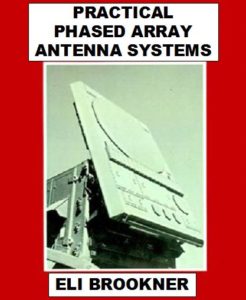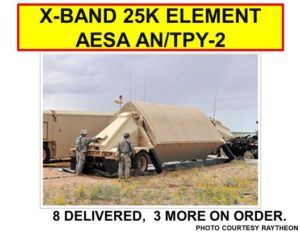Phased-Array and Adaptive-Array Fundamentals and Their Recent Advances
Spring 2018 Course
Dates: Mondays, March 19, 26, April 2, 9, 30, May 7, 14, 21
(Snow/make-up June 4, 11)
Time: 6 – 9 pm
Decision date: Monday, March 12, 2018
Early Registration Date deadline: Monday, March 5, 2018
Before Early Registration Date:
Members $300
Non-members $340
After Early Registration Date:
Members $340
Non-members $370
WHERE: MITRE Corporation* (Building S)
202 Burlington Road
Bedford, MA
*All non-US Citizens must be pre-approved for entrance to the MITRE facility. Please contact our office.
Phone 781-245-5405
email sec.boston@ieee.org
Fax 781-245-5406
If paying by check, the check must be received before the appropriate dates for Early Registration and Decision Dates.
Make Checks payable and send to:
IEEE Boston Section
One Centre Street, Suite 203
Wakefield, MA 01880
Speaker: Dr. Eli Brookner, Raytheon (Retired)
Course Overview:
Phased-Array and Adaptive-Array Fundamentals and Their Recent Advances
“Practical Phased Array Antenna Systems”, Dr. Eli Brookner, Editor, Artech House, 1991, Hardcover, 258 pages, List Price $179, Hardcover, 258 pages. Covers array fundamentals: phase and time-delay steering; grating lobes for 1- and 2-dimensional arrays; effects of errors and failures on gain, sidelobes and angle accuracy; array weighting, thinning, blindness, mutual coupling, elements, phase-shifters and feeds; limited field of view (LFOV) arrays; SPY-1; example design.
This course is based on the book entitled Practical Phased Array Antenna Systems by Dr. Eli Brookner. The book covers array basics and fundamentals which change little with time. The course, the book and the notes will provide an ideal introduction to the principles of phased array antenna design and adaptive arrays. The course material and notes covers developments in phased arrays updated to 2018. With the explicitly tutorial approach the course and book offers a concise, introductory level survey of the fundamentals without dwelling on extensive mathematical derivations or abstruse theory. Instead a physical feel will be given. The book provides extensive curves, tables and illustrative examples. Covered in easy terms will be sidelobe cancellation, Cognitive Adaptive Array Processing (CAAP) which provides optimum full adaptive array processing without suffering its computation complexity and other disadvantages. The mystery will be taken out of the new Mulitple Input Multiple Output (MIMO) array radar and Space-Time Adaptive Array (STAP) for airborne platforms. STAP will be explained and related to the displaced phase center antenna (DPCA).
All Attendees of the class will receive a trial license of MATLAB and Phased Array System Toolbox from MathWorks in addition to a set of examples which help demonstrate key array concepts covered in the course.
This course is intended for the engineer or scientist not familiar with phased-array antennas as well as the antenna specialist who wants to learn about other aspects of phased-array antenna systems as well as get the latest developments in array systems, such as: MIMO, metamaterial arrays, Digital Beamforming (DBF), Extreme MMIC arrays, stealthing and cloaking. The major emphasis will be on the system aspects of phased-arrays.
Lecture #1. Monday, March 19; Phased Array Fundamentals: Electronically Scanned Array (ESA) explained with tube COBRA DANE used as example. Covered will be: Phased Steering, Switched-Line Phase Steering; Time Delay Steering, Subarraying, Array Weighting, Monopulse, Duplexing, Array Thinning, Embedded Element, dual polarized circular waveguide element, advantage of triangular lattice over square lattice, Tour of COBRA DANE (6 stories high) via color slides.
Lecture #2. Monday, March 26; Linear Array Fundamentals: Conditions for no grating lobes; beamwidth vs scan angle; sine space; Array Factor; sidelobe level vs antenna beamwidth; directivity; antenna efficiency factors; array weightings; array frequency scanning; array bandwith.
Lecture #3. Monday, April 2; Planar Arrays: sine-space (sinα-sinß and u-v space); grating lobes location for triangular and rectangular lattice; very useful bell curve approximation; array thinning system issues. 2nd Generation Active Phased Arrays: Solid state active electronically scanned arrays (AESAs) covered using PAVE PAWS as example. Also covered are: T/R Module, Cross Bent Dipole Element, Array Blindness, Tour of PAVE PAWS (6 stories) via color slides given. 3rd Generation AESAs: These use microwave integrated circuits (Monolithic Microwave Integrated Circuits [MMIC]): THAAD (TPY-2), SPY-3, IRIDIUM, F-15 APQ-63(V)2, APG-79, XBR, AMDR and upgraded Patriot. Patriot now a 2015 state-of-the-art 3rd generation AESA radar system it now having MMIC GaN AESAs providing 360o coverage. S-band AMDR provides 30 times the sensitivity and can handle 30 times the number of tracks as the AEGIS SPY-1D(V).
Lecture #4. Monday, April 9; Array Errors: Effects of element phase and amplitude element errors and element failures; simple physical derivation of error effects given; paired echo theory; subarray errors; A/D quantization errors; examples. Radiating Elements: Waveguide; dipole; slotted waveguide; microstrip patch; stacked patch; notch (wideband); spiral; matching (wide-angle); waveguide simulator; practical limitations, mutual coupling, array blindness; scattering matrix; design procedure; polarization miss-match loss.
Lecture #5. Monday, April 30; Array Feeds: Corporate and space fed; Reactive (lossless) and matched (Wilkinson); even/odd node analysis. Serial; Ladder; Lopez; Blass; Radial, Butler matrix; microstrip/stripline; Rotman Lens on SLQ-32; PATRIOT space-fed array; reflectarray. 4TH Generation Digital Beam Forming (DBF) AESAs: Provides reduced search power and occupancy by nearly a factor of 2 (3dB) while improving the search angle accuracy, like by about 40%; Cognitive radar enabler; Ultra low antenna sidelobes enabler; Israel, Thales, Australia and Lockheed Martin (LM) AESAs have an A/D for every AESA receive element channel (172,000 for LM system); Raytheon developing element level mixer-less direct RF A/D reconfigurable between S and X-band in microseconds; MOORE’S LAW: Potential future continuation of Moore’s Law: via Spintronics, Memristor, Graphene, Quantum Computing.
Lecture #6. Monday, May 7; Limited Field-of-View (LFOV) Arrays: Explained using simple high school physics. Hemispherical Coverage Array: Dome Antenna. System Considerations: sequential detection, beam shape loss; receiver and A/D dynamic range; polarization miss-match loss; AESA noise figure and system temperature taking into account array mismatch. Phase Shifters: Diode switched-line, hybrid-coupled, loaded-line; ferrite phase-shifters: non-reciprocal latching; diode vs ferrite; MEMS (Micro-Electro-Mechanical Systems) and its potential for a low cost electronically scanned arrays (ESAs). AESA Breakthroughs – Part 1: Extreme MMIC: Can now put on single chip 256-Element 60 GHz Transmit Phased Array. Such arrays to cost only few dollars. Low Cost Packaging: Raytheon, Rockwell Collins, Lincoln-Lab./MA-COM and South Korea developing low cost flat panel S and X-band AESAs using commercial components, practices and printed circuit boards (PCBs); Materials: GaN can now put 5X to 10X the power of GaAs in same footprint. Metamaterials: Man made material which provides properties not found in nature. Coating of target with metamaterial has potential to make it invisible or stealthy. Has promise for: low cost 2-D ESAs for satellite internet communications; for cell towers, for radars.
Lecture #7. Monday, May 14. Sidelobe Cancellers (SLC): The simple single-loop, feed-forward canceller is introduced in easy physical terms. This is followed by a discussion of the simple single-loop feedback canceller with and without hard limiting. Multiple-loop SLC (MSLC) covered. Adaptive Arrays: The optimum Sample Matrix Inversion (SMI) algorithm for a fully adaptive array is developed using a very simple derivation. Cognitive Adaptive Array Processing (CAAP) introduced which lets one achieve the performance of SMI array without its disadvantages of the need for a large number of training samples, large computation load and sidelobe degradation. Displaced Phase Center Array (DPCA) and Space Time Array Processing (STAP) algorithm explained in simple terms and related. Ubiquitous least squares estimation (LSE) covered and applied to MSLC and tracking. Briefly introduce use of Gram-Schmidt, Givens and Householder orthonormal transformation methods of LSE. Systolic array implementations given.
Lecture #8. Monday, May 21; AESA Breakthroughs – Part 2: 5th Generation Ultra Wideband (UWB) AESAs: C to Ku band. MIMO Array Radars: Explained in simple physical terms rather than with heavy math. Gives attendees an understanding of where it makes sense to use. Contrary to what is claimed MIMO array radars do not provide 1, 2 or 3 orders of magnitude better resolution and accuracy than conventional array radars; also contrary to claims made MIMO should not provide better minimum detectable velocity for airborne radars. MIMO and Jamming: MIMO does not provide better barrage-noise-jammer, repeater-jammer or hot-clutter rejection than conventional array radars. Potential for automobile radars and radar combining covered. Technology and Algorithms: A dual polarized, low profile, (/40), wideband (20:1) antenna can be built using tightly coupled dipole antennas (TCDA); spurious free dynamic range (SFDR): Lincoln Lab increases SFDR of receiver plus A/D by 40 dB; Low Cost Printed Electronics: 1.6 GHz printed diodes achieved. Electrical and Optical Signals on Same Chip: Will allow data transfer at the speed of light; IR transparent in silicon. Biodegradable Arrays of Transistors or LEDs: Imbedded under skin for detecting cancer or low glucose. Quantum Radar: Has potential to defeat stealth targets!!!
Your Registration Includes: 1 textbook; 15 Reprints; over 800 Vugraphs; trial license of MATLAB and Phased Array System Toolbox from MathWorks with examples demonstrating key array concepts covered in the course.


